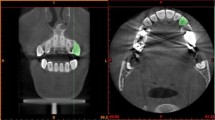Abstract
Aim:
This study was undertaken to calculate the stress in the tooth, surrounding periodontal ligament, and in the alveolar bone when a lower first premolar is subjected to intrusion or torque movement using a constant moment. Root resorptions occur even when very low forces and moments are used in orthodontic therapy. It is therefore of great interest to determine and measure the stress that occurs under particular treatment conditions in the periodontal ligament.
Material and Methods:
In this study, three finite element calculations were carried out with a realistic 3D model developed by CT data that consisted of a lower premolar, the surrounding periodontal ligament and alveolar bone. In close reference to the in-vivo experiments carried out by Faltin et al. [3, 5, 6] in São Paulo, Brazil, our model was subjected to an intrusive force on the premolar of 0.5 N and a lingual root torque of 3 Nmm.
Results:
The three main stress directions and hydrostatic stress were quantified in all the surrounding tissues, revealing that the hydrostatic stress profile in the periodontal ligament correlated closely with resorption findings in Faltin et al.’s patients. Resorption occurred in the experimental study in Brazil when the hydrostatic stress exceeded capillary blood pressure in the periodontal ligament.
Conclusion:
We maintain that hydrostatic stress represents a suitable indicator for potential root resorptions caused by higher forces and moments, making it a helpful tool in the development of new orthodontic appliances. We must of course mention that there are many factors other than forces that are responsible for resorptions. But at the moment, only the force can be influenced by the orthodontist.
Zusammenfassung
Ziel:
Das Ziel dieser Studie war die Untersuchung der Spannungen, die im Zahn und im umgebenden Parodontalligament und Alveolarknochen auftreten, wenn ein Prämolar einer Intrusion oder einem Torque ausgesetzt ist. Da Wurzelresorptionen selbst bei kleinen externen Kräften und Momenten als Nebenwirkungen einer kieferorthopädischen Therapie auftreten können, ist es von großem Interesse, die Spannungen, die bei einer bestimmten Behandlungssituation im Zahnhalteapparat auftreten, im Hinblick auf die Entstehung von Resorptionserscheinungen zu bestimmen und zu beurteilen.
Material und Methoden:
In dieser Studie wurde ein realitätsgetreues dreidimensionales Finite-Elemente-Modell eines unteren Prämolaren sowie des umgebenden Parodontalligamentes und Alveolarknochens aus Computertomographie-Daten generiert. In Anlehnung an In-vivo-Experimente, die in São Paulo, Brasilien von Faltin et al. [3, 5, 6] durchgeführt wurden, wurde das Modell mit einer intrusiven Kraft von 0,5 N bzw. einem lingualen Wurzeltorque von 3 Nmm belastet.
Ergebnisse:
In allen beteiligten Geweben wurden die drei Hauptspannungen sowie der hydrostatische Spannungsanteil ausgewertet. Es zeigte sich, dass das Profil des hydrostatischen Spannungsanteils im Parodontalligament sehr gut mit den in vivo gefundenen Resorptionen der Zahnwurzel korrelierte. Resorptionserscheinungen traten außerdem gerade an denjenigen Stellen der Zahnwurzel auf, wo der hydrostatische Spannungsanteil den kapillären Blutdruck im Parodontalligament überschritt.
Schlussfolgerung:
Der hydrostatische Spannungsanteil kann als geeigneter Indikator für das Auftreten von Wurzelresorptionen aufgefasst und für die Entwicklung neuer Behandlungselemente zur Vermeidung solcher Resorptionen verwendet werden. Es muss allerdings darauf hingewiesen werden, dass es neben den Kräften auch noch viele andere Faktoren für die Entstehung von Resorptionen gibt.
Similar content being viewed by others
Author information
Authors and Affiliations
Corresponding author
Additional information
The study was supported by a grant from the German Research Foundation DFG (SA 272/1-2).
Rights and permissions
About this article
Cite this article
Dorow, C., Sander, FG. Development of a Model for the Simulation of Orthodontic Load on Lower First Premolars Using the Finite Element Method. J Orofac Orthop 66, 208–218 (2005). https://doi.org/10.1007/s00056-005-0416-5
Received:
Accepted:
Issue Date:
DOI: https://doi.org/10.1007/s00056-005-0416-5
Key Words:
- Root resorption
- Finite element method
- Development of a realistic model
- Stress
- Hydrostatic pressure in the periodontal ligament




